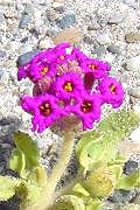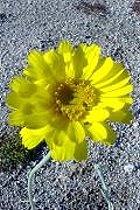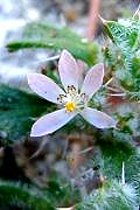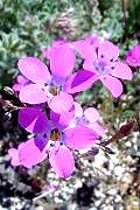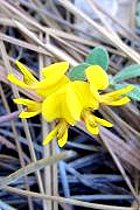-
Jacaran'da: a Brazilian vernacular name. The genus Jacaranda was published by Antoine Laurent de Jussieu in 1789.
-
ja'cens: from Latin jacens, "to lie along," from jaceo, "to lie or to be situated," thus fallen, prostrate or lying. Gledhill says: "hanging loose, lying flat." The sole taxon with this epithet in the California flora is Gilia jacens, which used to be Gilia brecciarum ssp. jacens.
-
jacinten'sis: same as following entry.
-
jacin'teus: from Mt. San Jacinto, California.
-
jacin'ticum: same as previous entry.
-
jack'ii: named for John George Jack (1861-1949), a Canadian dendrologist and plant collector at the Arnold Arbor-
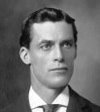 |
|
etum in Boston. He was born at Quebec, Canada, of Scots descent. He was schooled in horticulture by his mother Annie Jack who wrote articles for the Garden News. He was not college-educated but after amassing much experience he came under the sway of the legendary Professor Charles Sargent at Harvard. In 1891 Sargent recommended him as a lecturer in arboriculture. He taught classes in plant identification at the Arboretum despite being color-blind. From 1898 he worked with the USDA and the US Geological Survey exploring forests first in Wyoming and Colorado, |
and then in Europe, Canada, Japan, Taiwan and Korea. From 1903 to 1908 he was an instructor in forestry at Harvard and then at MIT. In 1908 he was appointed a professor of dendronology at the Arnold Arboretum. Among the many that he instructed was a generation of Chinese botanists. He also visited the island of Cuba to study flora there. The genus Sinojackia was named in his honor. There is also another specific epithet Utricularia jackii named by John Adrian Naicker Parnell for his father, John "Jack" Thomas Mackie Parnell. (Photo credit: Arnold Arboretum)
-
Jackson'ia: named for John Jackson (1748-1821) and/or for William Jackson (1789-1864) or James Wayne Dalton Jackson (1787-1857). Derivation up in the air. John Jackson, born in London Grove, Pennsylvania, was the son of William Jackson (1705-1785), and grandson of Isaac Jackson who emigrated from Ireland. He inherited the family’s 300-acre estate Harmony Grove upon the death of his father in 1785. He was a self taught botanist who took delight in cultivating in his leisure hours a garden which he stocked with a multitude of native and foreign fruits and flowers, a garden that compared favorably with that of his Pennsylvania Quaker contemporary and friend Humphry Marshall. He traded seeds with fellow domestic and European botanists, and in his later years spent most of his time in his garden. He also studied mineralogy and was a member of the Chester County Cabinet of Natural Science with other local botanists including Marshall, Joshua and Samuel Pierce (owners of the arboretum that would later become Longwood Gardens), Dr. Francis Allison, Dr. William Baldwin, and Dr. William Darlington. His older brother was William Jackson (1746-1834), a Quaker minister. William Jackson (1789-1864) was the son of John Jackson and the nephew of William. He attended Westtown and then Enoch Lewis' boarding school at New Garden and in turn inherited the family estate, continuing many of the gardens started by his father. He was elected to the Pennsylvania State Senate in 1838 and served a single term. He was active in the anti-slavery movement, publishing the work Views of slavery, in its effects on the wealth, population, and character of nations. James Wayne Dalton Jackson (1787-1857) was a professor at the University of Georgia who sent Stephen Elliott specimens that included Elliottia racemosa and Penstemon dissectum. I can find no evidence that he bore any relation to the other Jacksons. The genus Jacksonia was included in either the Capparaceae or Cleomaceae, considered an invalid genus, and was published by Constantine Samuel Rafinesque in 1808. Since William would only have been about 19 at the time, and James Wayne Jackson about 21, it seems unlikely that either of them should have been the one so honored.
-
Jacobae'a/jacobae'a: an epithet applied to plants and deriving from two different
possible sources: (1) from St. James (Jacob or Jacobus), one of the
12 Apostles; or (2) referring to the island of St. Iago in the Cape
Verde Islands. The website CasaBio says "Possibly for St James (Jacobus), one of the 12 apostles, because the plant flowers around St Jacobs day, July 25. The phrase ‘conditio Jacobaea’ means ‘If the Lord wills it.’ The author may have had in mind that this ragwort plant was only tolerated as part of God’s will. St James is usually depicted as an older man with grey or graying hair and somewhat unkempt beard. The plant’s leaves and stems are covered with long, thinly to thickly matted gray-white to white hairs." The naturalized Senecio jacobaea (the only taxon in the California flora with this epithet) has an astounding variety of names in the UK including bragweed, bunnel, bunweed, cammock, cankerweed, cankerwort, cheadle-doc, cow foot, cradle-dock, cushag, devil dums, dog standard, fairies' horse, felon weed, field ragwort, fizz gig, fleewort, fly flower, gander-goose, gipsy, grand swaith, hammerwort, herb St. James, ketlock, marefart, mountain ragwort, muggart, ragged Jack, ragged Robin, rayless ragwort, scattle-dock , scrape-clean, scrog, seggy, sigrum, sleepy-dose, St. James' flower, staggerwort, stammer wort, stinking alisander, summer's farewell, swine's cress, swine's grass, tansy, tirso, , water groundsel, weeby, wild chrysanthemum, yack-yard, yallers, yarkrod, yellow daisy, yellow elshinders AND OTHERS. In the US it’s just called cankerweed, fairies-horse, felon weed, kettle-dock, Saracen's compass, St. James' wort, staggerwort and stavewort.
-
jacquinia'num: named for Joseph Franz von Jacquin (1766-1839), a professor and botanist, son of Nicholaus (Nicolaas
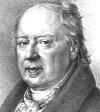 |
|
or Nikolaus) Joseph von Jacquin (1727-1817), the fanous Dutch scientist who studied medicine, chemistry, mineralogy and botany. Joseph Franz was born in Schemnitz, Slovakia, and studied medicine, chemistry, zoology and botany. He graduated from the University of Vienna as a doctor of medicine in 1788. Between 1788 and 1791 Jacquin was sent on a scientific journey to Germany, France and England by Emperor Francis II. He succeeded his father as professor of botany and chemistry at the University of Vienna and remained in that position from 1797 until his retirement |
in 1838. He also served as director of the botanical garden, and was a close friend of Nicolaus Host, Croatian botanist and the personal physician of Holy Roman Emperor Francis II, and accompanied him on plant collecting trips throughout central Europe. He was elected a foreign member of the Royal Swedish Academy of Sciences in 1821 and wrote several notable botanical books including Beyträge zur Geschichte der Vögel (Report on the History of Birds) (1784), Lehrbuch der allgemeinen und medicinischen Chymie zum Gebrauche seiner Vorlesungen (1798), Eclogae plantarum rariorum aut minus cognitarum: quas ad vivum descripsit et iconibus coloratis illustravit, and Ueber den Ginkgo (1819) . He died in Vienna.
- jae'geri/jaegeria'na/jaegeria'nus: named for Edmund Carroll Jaeger (1888-1983), author of Desert Wildflowers and other works on desert ecology, professor of biology and curator of plants at the Riverside Municipal Museum. He was born in Nebraska and moved with his family to Riverside, California, in 1906. He attended Occidental College in Eagle Rock, Los Angeles, in 1914 but moved to Palm Springs the following year where he taught in a one-room schoolhouse. He traveled with friends throughout the Southwest learning about desert ecology, and then returned to Occidental to complete his degree in 1918. He started teaching at Riverside Junior College and retired from that occupation after 30 years to work at the Riverside Municipal Museum. He became known as the dean of the California deserts, thanks in large part to his many books including The Mountain Trees of Southern California, Denizens of the Desert, Birds of the Charleston Mountains of Nevada, Denizens of the Mountains, The California Deserts: A Visitor’s Guide, Desert wildflowers, A Naturalist’s Death Valley, and others. One of the species that bears his name is the now recognized Yucca jaegeriana, thought for a long time to be just the eastern form of the Joshua tree, Y. brevifolia.
-
Jaffueliobry'um: named for Père Félix Jaffuel (1874-1939), a French priest, botanist, entomologist and zoologist. He
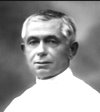 |
|
was born at Lozère in the hamlet of Crouzet, parish of St. Sauveur de Ginestoux, not far from the famous Châteauneuf de Randon. He did humanities studies at the apostolic school of Sarzeau. He arrived in Chile in 1892 as a young novice and studied at the Convent of Los Perales, Atacama. He was enlisted in the faculty of the College of Santiago and had a long career as a professor, teaching natural history, general history, algebra, geometry, physics, cosmography, philosophy of law, and history of literature, although botany, entomology and zoology were his favorite subjects. JSTOR |
says: “Alongside his religious work, Jaffuel was an enthusiastic naturalist and collected plants and insects in Chile and Bolivia. He published numerous monographs in the Revista Chilena de Historia Natural and was one of the founders of the Entomological Society of Chile. Among his expeditions were two trips to Bolivia between 1922 and 1924, to Kala Uyu (15 km north of La Paz) and Mururata, collecting at an altitude of 4,500-5,000 meters in each place. He found many mosses which he brought to the attention of his correspondent and friend, the bryologist I. Theriot. He also traveled to Easter Island in 1927 and returned to France in 1939, where he died.” The outstanding collection of natural history materials which he and his fellow Fathers had assembled were unfortunately lost in a fire which destroyed the College of Santiago in 1920, but he soldiered on and helped to rebuild the college. Eight days before his death, he became a corresponding member of the Institute of Sciences, Letters and Arts of Campinas, State of Sao Paulo (Brazil). He published textbooks on geography, history and zoology. The genus Jaffueliobryum was published in 1928 by Marie Hypolite Irénée Thériot. (Photo credit: Congrégation
des Sacrés-Coeurs de Jésus et de Maria)
-
jala'pa: of Jalapa (originally Xalapan), Veracruz, Mexico. This is a plant (Mirabilis jalapa) in cultivation and occasionally found as a garden escape in California, the name jalapa coming from the Spanish xalapa and in turn from Nahuatl xalapan which meant "spring in the sand," and being
the specific epithet of the species called marvel of Peru, and referring to the drug jalap which was incorrectly
assumed to have been extracted from this plant. After the Spanish invaded Mexico and among the local populations which included Spaniards, mestizos and indigenous peoples, items of local commerce included botanical medicines particularly the plant named Ipomoea purga which was the source of a drug known in English as jalap, a cathartic, diuretic or purgative drug used to aid in defecation.
-
James'ia/jamesia'na/james'ii: named for Edwin P. James
(1797-1861), an American naturalist and botanical explorer
 |
|
in the Rocky Mountains. He was born in Weybridge, Vermont, and was schooled at Addison County Grammar School before entering Middlebury College in 1812 and receiving his AB degree in 1916. He studied medicine, then learned botany from Professor John Torrey, and in 1820 became the naturalist-surgeon of the federal government's Yellowstone Expedition led by Major Stephen Harriman Long into still largely unknown territory acquired in the Louisiana Purchase, exploring the Rockies all the way south into New Mexico. William Baldwin, the original botanist/surgeon of |
the Long expedition, had died the first year, opening the way for James to take that position. He and two colleagues were the first (non-native) Americans to ascend Pike's Peak, and he was the first plant collector to explore the high alpine regions of the Rocky Mountains. During the expedition James collected about 700 plant species in the mountains and over the prairies, of which 140 were new to science. Malaria delayed his return to Philadelphia until the autumn of 1821. He was assigned the primary responsibility for writing the account of the expedition, which was published in 1822. Wikipedia adds the following: “Subsequently James was appointed US Army surgeon to serve at various frontier outposts including the Great Lakes region; he served from 1823 to 1833. While with the Army he interacted with native Americans, most notably the Ojibwe with whose language he became familiar. A EuroAmerican, John Tanner (captive), captured by the Ojibwe when a child and raised among them, worked closely with James in the production of the New Testament in the Ojibwe language, and in the telling of Tanner's life story. In 1827, while still working for the Army but during a return visit to the East, James married Clara Rogers. His ' ... beautiful wife ... was a woman of talent and fond of society ... ' They had one child, a son named Edwin Jr., born in 1828. By ca. 1840 (the exact date is uncertain) they had permanently settled on land near Burlington, Iowa, which they developed into a productive farm. There James maintained in his house a station on the Underground Railroad. Clara died in 1854, leaving James in great sorrow. James himself died in 1861, the result of an accident on his farm.” Contrary to what some people think, the James Reserve in the San Jacinto Mountains which is part of the University of California Natural Reserve System, was not named for Edwin James, but rather for Harry Clebourne James (1896-1978), who moved to California from Ottawa, Canada, was responsible for establishing a number of organizations and scouting clubs and for the San Gorgonio Wilderness. The genus Jamesia was published by John Torrey and Asa Gray in 1840. ( Carex jamesii, Cryptantha jamesii, Mimulus jamesii, Pleuraphis jamesii, Stellaria jamesii)
-
jamesia'na: named for Thomas Potts James (1803-1882), an American botanist and bryologist. He was born in Radnor,
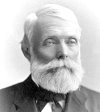 |
|
Pennsylvania, and was descended from leaders of the American Revolution and framers of the Constitution. The town of Pottstown, Pennsylvania (where I incidentally went to school) was named for his family. He studied botany as a youth and made mosses his specialty, receiving early education in Trenton, New Jersey. He had intended to enter Princeton but was prevented by circumstances from doing so. For almost forty years he worked with his brother in the wholesale drug business and was an instructor at the Philadelphia College of Pharmacy but remained active |
with botany as well. He was married in 1851 and moved with his new wife to Cambridge, Massachusetts. He was a Union sympathizer and a member of the National Guard during the Civil War. He was the co-author with Leo Lesquereux, of the Manual of the Mosses of North America published in 1884, and the author or co-author of 75 names of musci. He also wrote the section on mosses and liverworts in William Darlington's Flora Cestrica (1853). He was a member of the earliest circle of American bryologists, a group which included Lesquereux, Austin and Sullivant, all of whom were prolific correspondents. He was an active member and librarian of the American Philosophical Society and the Academy of Natural Sciences in Philadelphia. While in Cambridge, he was in daily contact with the great Harvard botanist Asa Gray. He died at home following a stroke.
-
james'ii: named for Dr. Frederick Charles James (1935-2002). The following
is from the Greenville, South Carolina,
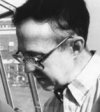 |
|
News: "Dr. Frederick
C. James, age 67, died Friday, July 19, at the Baptist Hospital in
Columbia. He was born in Long Beach, Calif., and was a son of the
late Charles and Caroline Jicha James. Dr. James, affectionately known
as 'Scrap Iron James' was a graduate of East Carolina University in
Greenville, NC, and received his PhD in botany from the University
of North Carolina, Chapel Hill, NC. He taught at Westmar College
in LeMars, Iowa for two years before he began his long career at Presbyterian
College teaching there for 31 years and just retiring at the end of
this |
school year. Dr. James was so loved and respected by his students
at PC, that twice he was selected professor of the year, first in
1982 and second in 2002. One of his students went on to discover a
new plant and named it Smilax jamesi in honor of Dr. James.
He was also well-known for his biology trips to the Virgin Islands,
Puerto Rico, the Bahamas, Ecuador, the Galapagos Islands, Africa and
Hawaii. Not only was he known by his friends for his great sense of
humor and friendly manner, but as a member of the Virginia High School
Hall of Fame for scoring 83 points in a single basketball game, the
most points ever scored in a single game." (Photo credit: UNC Herbarium)
-
Jamesoniel'la: named for William Jameson (1796-1873), a Scottish-Ecuadorian botanist born in Edinburgh who studied at the Royal College of Surgeons of Edinburgh. He embarked on several voyages as a ship’s surgeon to Baffin Bay and South America. He first arrived in Lima, Peru, practiced medicine at Guayaquil until 1826 when he settled in the better climate of Ecuador. He was appointed in 1827 professor of chemistry and botany at Universidad Central del Ecuador. In 1832, he was made assayer to the mint and then director in 1861. In 1864, the Ecuadorean government appointed him to prepare a synopsis of the flora of the country, and he began writing a flora of Ecuador, Synopsis Plantarum Aequatoriensium, of which Volumes 1 and 2 were published in 1865. Part of a third volume was printed but the work was never fully completed. He went back to Edinburgh in 1869, stopping in Argentina to visit his three sons who had settled there, and returned to Quito in 1872, dying not long thereafter. He had frequently corresponded with major botanists such as both of the Hookers and sent home many new species of plants. He was married and converted to Catholicism while in Ecuador, and was made a Caballero of Spain by Queen Isabella in recogntion of his work. In 1830 William Jackson Hooker and Robert Kaye Greville published a genus of ferns in the Pteridaceae for him (Jamesonia). The genus Jamesoniella was published by Frederick Arnold Lees in 1881.
-
janish'iae: named for Nevada artist Jeanne Russell Janish (1902-1998), a botanical and paleontological illustrator
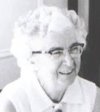 |
|
who traveled extensively in China as a young woman and produced many pencil drawings and watercolors of that country, particularly its flora. As a youth she spent summers in Colorado where she learned the names of many plants of the Rocky Mountain region. She was a Latin major at Vassar College graduating in 1924, then received a masters degree in geology at Stanford. Her career in botanical illustration began there with work on Permian ammonites by her paleontology professor. She was in China from 1920 to 1934 and she got married there to Carl Frederick Janish. |
Upon her return she and her husband moved to Nevada. In her later years, she concentrated on the Southwestern region of the US. Between 1929 and 1974 she prepared illustrations for thirty-two major books in addition to many short papers and articles. Her work illustrated Roxana Ferris's Flowers of the Point Reyes National Seashore and Abrams' Flora of the Pacific States. (Photo credit: New York Botanical Garden)
-
japon'ica/japon'icum/japon'icus: of or belonging to Japan, Japanese.
-
Jara'va: named for Juan de Jarava, a pseudonym of Francisco de Enzinas (aka Francis Dryander) (1518-1552), a
 |
|
classical scholar, translator, author, and Protestant reformer. Francisco de Enzinas was born in Burgos, Spain, one of ten chldren of a prosperous wool merchant. He was sent to the Netherlands around 1536 for commercial training. but enrolled at the Collegium Trilingue of Louvain in 1539, where he was influenced strongly by the humanist scholarship of Erasmus. In 1541 he went to Paris and enrolled at the University of Wittenberg. He spent much time with the famed hellenist Philip Melanchthon and finished a translation of the New testament into Spanish, taking it later to |
Antwerp to be printed in 1543. His translation was proscribed by the Inquisition, and following an interview with the Emperor Charles V, he was arrested by order of the Emperor's confessor, Pedro de Soto. He escaped from the Vrunte prison in Brussels in February, 1545, and made his way back to Wittenberg to write an account of his adventures, titled De statu Belgico et religione Hispanica, and better known as his Mémoires. His translation of the New Testament had a profound influence on subsequent translations, of which the most important was the Reina-Valera version, still the standard Bible of the Protestant Spanish-speaking world. Around this time he founded a Protestant colony in Constantinople (now Istanbul). His brother, Diego de Enzinas, was burned at the stake by the Roman Inquisition in 1547. In 1548 he married a fellow religious exile and moved to England, where Thomas Cranmer took the couple into his palace at Lambeth and soon afterward appointed him to teach Greek at Cambridge although it seems unlikely that he was ever granted a professorship. He tutored one of the sons, probably Charles, of the Duchess of Suffolk who combined Protestant convictions with a Spanish bloodline traced through her mother, and his translation of Plutarch's Lives was published under the pseudonym of Juan Castro de Salinas, one of several that he used during his lifetime, another of which was Francisco de Chesne. By this time his primary interest was in producing Spanish translations of Old Testament books and classical writers such as Lucian, Livy and Plutarch, and he engaged continental printers to accomplish this for him. In 1550 his family followed him to Strasbourg. He died in 1552 a victim of the plague in Strasbourg.The genus Jarava was published by Hipólito Ruiz López and José Antonio Pavon in 1798.
-
jared'ii: named for Lorenzo Dow Jared (1831-1909). Born near Jacksonville,
Illinois, Jared received an MD at Eclectic Medical College of Cincinnati
in 1857. He was an assistant surgeon with the 23rd Illinois Volunteer
Infantry from March to July, 1865, then moved to California. He settled
in Los Nietos (Los Angeles County) from 1870 to 1875, Santa Maria
(Santa Barbara County) from 1876 to 1882, and Estrella (San Luis Obispo
County) from 1883 to 1906. He lived the remaining years of his life
at the Soldiers Home in Sawtelle, back in L.A. Co. David Hollombe
sent me the following: "He lived on the Estrella plain of San
Luis Obispo County, and after many years' study made a list of the
native plants of the region which is the first list for any part of
that great interior and is still in existence in manuscript.... While
resident [there] he wrote a series of articles on the uses of the
native plants for the San Luis Press, a newspaper at San Luis Obispo."
-
Jas'minum: a late Medieval Latin version of
the Persian name yasmin for sweetly-scented plants. The genus Jasminum was published by Carl Linnaeus in 1753.
-
jas'perae: named for Harriet Angeline Boushey (Mrs. William Jasper) (1849?-1925). She was born Harriet Angeline Boucher in Chatham, Ontario, descended from ancestors of French lineage. and moved with her family via Panama to California in 1866, living first for two years in San Francisco. This was when the family name was changed from Boucher to Boushey. She was married to William Jasper, a native of Bremen, Germany, and a machinist and locomotive engineer by trade, and collected plants in the San Emigdio Canyon area of Kern County, where her father, Stephen Boushey, had established antimony mines. She may have met Alice Eastwood there. She died in Los Angeles. Her husband died in 1903.
-
jat'tae: named for Antonio Jatta (1852-1912), an Italian agronomist, botanist and politician associated with the Naples
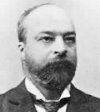 |
|
cryptogam school founded by Vincenzo Cesati in the second half of the 19th century. He was born in Ruvo de Puglia the son of a learned archeologist. He completed his secondary school education at the Umberto I High School in Naples and then graduated with honors in Natural Sciences at the University of Naples and in Agriculture at the Higher School of Agriculture in Portici. He began advocating for a complete agrarian transformation from large estates to smaller farms of almonds, olives, wheat and grapes, and helped to establish the Banca Agricola to assist small farmers and |
protect them from usury. He was a member of every agricultural institution in the province and as part of the municipal administration of Ruvo spoke at all agricultural meetings. At the age of 29 he was appointed provincial councilor, a position which had been his father’s and which he then held for 22 years, filling such posts as secretary up to vice-president. He was president of the Provincial Tax Commission and as such was in charge of important institutes dealing with archeology and the Archeological Museum of Bari. He fought for construction of the Pugliese Aqueduct to provide drinking water and expanded the Bari-Lecce Railway. He participated in diplomatic missions to Paris and London, and was also the head of the administration of the Monte di Pietà of the city of Ruvo, transforming it into a hospital. In 1886 he was decorated with a gold medal by the government for the courage and industriousness with which he distinguished himself in the cholera epidemic, putting his health at risk. During all these municipal and administrative duties, he was nevertheless not distracted from his studies, of which he favored botany and specialized in lichens. He understood that the cryptogamic field was still little explored, and he published in 1874 in the Italian Botanical Journal the first two parts of his Lichens of Southern Italy which eventually became the Lichenes of Flora Italica Cryptogamica published in 1911. His other major work was the Sylloge Lichenum Italicorum (1900). He was a dedicated botanical collector of cryptogams and other plants, of which was the Herbarium Jattae containing dried plants, and also bryophytes, algae, mushrooms and lichens (of which he had about 10,000 specimens from all over the world. He belonged to the Italian Botanical Society and the Société Botanique de France, the Cryptogamological Society of Milan, and the Society of Natural Sciences and Mathematics of Naples. Beyond these fields, he devoted himself to studies of paleontology, archeology and the history of civilization in southern Italy and the prehistoric geography of Bari. A translation of an Italian Wikipedia page says: “With his ingenious talent, ready intuition, firmness of character and unparalleled activity, his whole life was of study and work, despising the softness and the idle life of rich people. He used polite and familiar ways with anyone, regardless of people. With the peasants, in preference, he treated good; he talked with them, encouraged them to work, gave them advice and help, took into account their families and their economic conditions, so that his name soon became popular. He might seem intransigent at times, inflexible in his opinions, then sometimes gruff, but he was constantly good and alien from any artifice, as he was used to a modest simplicity of life.” He died in his hometown of Ruvo.
-
Jaume'a: named for Jean Henri Jaume Saint-Hilaire
(1772-1845), a French botanist. The following is quoted from a Rare
Books website of the Missouri
Botanic Garden: "Jean Henri Jaume Saint-Hilaire was born
on October 29, 1772 in Grasse, a small town in Alpes-Maritimes, about
fifteen kilometers north of Cannes. His family was probably of the
upper bourgeoisie, and his intended career may have been to take part
in the family enterprises, perhaps as a banker. The family name was
Jaume, and he added the Saint-Hilaire at a later date; it is actually
the name of a rural quarter of the old town section of Grasse. A biographer
has suggested that he made the name change so that he would not be
identified with another member of his family, Henri-Honore Jaume,
who was a "local Jacobin terrorist." Very little is known
about Jaume's early life and education, but he presumably had a comfortable
upbringing and was educated locally. When he was twenty years old,
he joined the Revolutionary Army as an artillery officer, and served
with distinction in the Italian campaigns. In 1800, he resigned his
commission, and went to Paris to study the natural sciences. His interest
in botany may have developed from the fact that Grasse was a center
for the perfume industry, and was a town surrounded by flowers. Jaume arrived in Paris at a time when
significant institutional changes were underway, as successive Revolutionary
governments sought to sweep away the structures of the Old Regime,
and replace them with institutions compatible with the revolutionary
theme of egalitarianism. For example, the Jardin du Roi, which had
continued to function during the early years of the Revolution, was
abolished by the National Convention by a decree of June 10, 1793.
In its place was created the National Museum of Natural History, which
included a botanic garden, a library for natural history, a menagerie
or collection of foreign animals, and an amphitheatre or lecture room.
Another organization changed by the Revolution was the Académie
Royale des Sciences, which was abolished on August 8, 1795, and replaced
by a decree of October 24, 1795 with the National Institute to consist
of 144 members. The members were divided in classes, with the first
class, mathematics and physics, arranged in ten sections. The seventh
section was botany and plant physiology, and the first members were
Michel Adanson, René Louiche Desfontaines, Antoine Laurent de Jussieu, Charles Louis L'Heritier
de Brutelle, Jesan-Baptiste Lamarck, and Étienne Pierre Ventenat, along with Louis Jean-Marie
Daubenton of the section of anatomy and zoology. This was the distinguished
company with whom Jaume was first associated in Paris. Jaume must have made a favorable impression
as a student in the natural sciences, for, after just two years in
Paris, he was asked to write a popular guide to the museum. At the
time, he was studying floral paintings with Gerard van Spaendonck,
and may have worked with Pierre Joseph Redouté, the master
artist who tutored more than a generation of flora painters. Jaume
Saint-Hilaire's studies in science combined with his artistic training
emphasize the fact that, as his later works were to demonstrate, he
was both scientist and artist. In 1805, he published, at his own expense,
his first major work, Exposition des familles naturelles et de
la germination des plantes, contentant la description de 2337 genres
et d'environ 4,000 especes, 112 planches dont les figures ont ete dessinées
par l'auteur. Simply described, this was a popularized version
of the classification system of A.L. de Jussieu, who was a strong
advocate of the “natural” system of classification. Jaume
had done a number of experiments on plant germination before beginning
the book, and emphasized its importance to taxonomy. Jaume differed
from de Jussieu in some respects, and added three family names—Amaryllidaceae,
Lythraceae, and Verbenaceae—which are permanently established
in botanical nomenclature. Jaume, who lived on a small military pension,
had published at his own expense, as he was to do with subsequent
works. He hoped thereby to earn a comfortable living, but this did
not happen and, despite the fact that his writings were well received,
he lived close to poverty for most of his life. Over a number of years, Jaume worked
on Plantes de la France: Décrites et peintes de'apres nature.
This was a ten-volume work, published in two distinct periods—1808-1809
and 1819-1822; it contains 1,000 color-printed stipple engravings of
drawings by Jaume himself. Among his other publications were: Mémoires
sur les indigoféres du Bengale et de la Chine (1826), Mémoire
sur la culture du poivrier noir (1827), Traité des arbrisseaux
et des arbustes cultivés en France et en pleine terre (1825), Traité des arbres forestiers (1824), La flore et
la pomone francaises (1828-1833), Flore paisienne (1835), Les Dahlia (date ?), and Recueil de mémoires sur l'administration
des forêts, sur les arbres forestiers et l'économie.
Jaume's publications relating to forests show his lifelong dedication
to forest protection and conservation. During the Napoleonic period
and before, the forests of France had been ruthlessly exploited, and
Jaume hoped that, following the Restoration, a new attitude might
prevail. In 1820, the Bourbon government called for a new forest code
and, in 1824, a school of forestry was established at Nancy. When
the government began the planting of trees along main highways, Jaume
regarded this as a personal triumph for his advocacy. In 1827, a new
forest code was adopted which incorporated many of the reforms proposed
by Jaume and other natural scientists. Perhaps because of his interests
in forest cultivation and conservation and other practical themes
in agriculture, in 1831, Jaume was elected a member of the Societe
Royal and Central d'Agriculture. In another area of practical botany,
Jaume concerned himself with the commercial possibilities of a dye
plant, Wrightia tinctoria. During a trip to Great Britain in 1815,
he had become acquainted with the British commercial policies that
enabled entrepreneurs to reap profits from useful plants. In the years
following the Restoration, he attempted to persuade the government
of the commercial possibilities of Wrightia tinctoria and other dye
plants that could be substituted for the traditional sources of indigo.
He was able to produce a superior blue dye from the plant, Polygonum
tinctorum, but failed to receive any reward for his work. He also
advocated government action in the area of colonial agricultural productivity,
believing rightly that successive governments had failed to capitalize
on the production of commodities such as black pepper, cinnamon, and
others. However, no serious emphasis was developed in French colonial
agriculture until later on in the 19th century. Jaume Saint-Hilaire obviously had a
life filled with interests, activities, and achievements, but it may
have been a disappointing and frustrating life in many respects. Financial
rewards escaped him as did professional recognition. For example,
in spite of two nominations, he was not elected to the Academy of
Sciences; in retrospect, his numerous scientific publications and
his advocacy of the use of botanical science for the improvement of
agriculture and related fields should have brought him the appropriate
rewards." Based on the pronunciation of the original French name Jaume, this epithet should correctly be pronounced "ZHOME-a" or "ZHOME-ee." The genus Jaumea was published by Christiaan Hendrik Persoon in 1807.
-
jef'freyi:
named for John Jeffrey (1826-?),
a Scottish gardener, botanist and plant collector at the Royal Botanic Garden in Edinburgh and discoverer of the Jeffrey
pine in the Shasta Valley of California in 1852. He was born at Forneth, Perthshire, Scotland, only a few miles from the birthplaces of Archibald Menzies and David Douglas, and he can be assumed to have had at least some early education. When he was 15 he was a servant at East Blair House a few miles away from where he lived in Lochore. He began working in 1849 as a gardener at the Royal Botanic Garden, Edinburgh, where he reportedly came to the attention of James McNab, curator of the garden. Under the auspices of the RBGE and a Scottish organization known as the Oregon Botanical Association, Jeffrey set out in 1850 from Scotland to Hudson's Bay to collect plants for the Association, sailing on the Hudson's Bay Company's vessel Prince of Wales. From there he traveled across the continent 1,200 miles on foot to the Saskatchewan River, bracing temperatures of 30-40 degrees below zero. In January, 1851, he made a two-week trip to the Athabasca River where he remained until April. By the fall of 1851 he was at Fort Victoria in British Columbia, having collected on Vancouver Island. The summer of 1852 was spent in the Willamette Valley, the Cascade Mountains, and by September Mt. Shasta. He reached the San Francisco area by the fall of 1853 and was there at least until January, 1854. There is evidence that he joined an expedition to Fort Yuma to explore the Gila and Colorado Rivers. He also apparently reached Fort Yuma on the Gila just where it joins the Colorado, and letters had that as his address, and then he vanished from the historical record while apparently traveling from San Diego across the Colorado Desert. He had collected many plants in Oregon as he traveled between Fort Vancouver on the Columbia River and San Francisco. One of the pines he collected was originally classified
as a variety of ponderosa pine due to similar physical appearance
and geographic range, but was later determined to be a separate species, known to us today as the jeffrey pine. Because Jeffrey did not keep a journal of his travels, not much is known about his time in Oregon, and historians know little about the rest of his life. There have been suggestions that he may have been murdered or otherwise came to a bad end. In the latter part of his explorations, the Oregon Botanical Association had become disenchanted with his work and complained that he was not following the procedures that had been agreed upon. Although attempts were made to contact him, he was never seen or heard from again. It's very strange because he was presumably with other people and if something had happened to him, there would have been other people who would presumably have been aware of it. The parallels between his life and that of David Douglas are striking. Both from the very same area, both having traveled over much of the same territory and collected some of the same plants, both having died at a very early age, and the details of their deaths remaining essentially a mystery.
-
jenkins'ii: named for Leslie Jenkins (1908-1961), a Canadian amateur botanist. He was born in Sault Ste Marie, Ontario, Canada, to a blacksmith father. He earned a BA and a BSA degree from the University of Saskatoon. He died in Kindersley, Saskatchewan at the age of 53.
-
jen'neri: named for Charles Jenner (1810-1893), a British-born Scottish department store owner, botanist, algologist and fellow of the Royal Society of Edinburgh born in Chatham, Kent. His father was an innkeeper and he spent much of his youth in Rochester where he was apprenticed at the age of thirteen to a local draper. He moved to Edinburgh in 1829 and founded Jenners Department Store, also known as Kennington and Jenner, in 1838 with his partner Charles Kennington. When Kennington died in 1874, the store became Charles Jenner & Co. The original building was destroyed by fire in 1892 and a new structure was erected in 1895. It has remained in that location on Prince’s Street and was the oldest independent department store in Scotland until its acquisition by House of Fraser in 2005. It was visited by Queen Elizabeth upon the occasion of its 150th anniversary. Charles Jenner however was much more than a department store owner. He was very active in the intellectual life of his times, especially in the areas of botany and geology, and was president of the Botanic Society of Edinburgh. His younger brother, Sir William Jenner, became Queen Victoria’s personal physician.
-
Jen'sia: named by Bruce Baldwin for Jens Christian Clausen (1891-1969),
a Danish botanist, ecologist and geneticist.
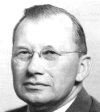 |
|
He received his BS, master's
and doctoral degrees at the University of Copenhagen and became an
assistant professor at the Royal Agricultural College. He moved to
the United States in 1931. He held a research appointment at the Carnegie
Institution of Washington and at Carnegie's laboratory at Stanford
University. At the time taxonomist Harvey Monroe Hall was conducting
experiments in transplanting native plants into different ecological
environments to see how they developed. In 1932 Clausen was invited
to join Hall's group, but within a few months Hall died and Clausen |
took over the work. With his colleagues David Keck and William Hiesey,
over the course of two decades, he established that new species can
result from rapid or extreme environmental changes. In 1951 he published Stages in the Evolution of Plant Species and was from 1951
to 1956 a professor of biology at Stanford. He was elected to the
National Academy of Sciences in 1959 and the American Academy of Arts
and Sciences in 1961. Also in 1961 he was knighted by King Frederick
IX of Denmark. The genus Jensia was published in 1999 by Bruce Baldwin. (Photo credit: Geni)
- Jepson'ia/jepsonia'na/jepsonia'nus/jepson'ii:
named for Willis Linn Jepson (1867-1946), a major California botanist
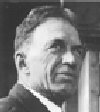 |
|
who by the age of 13 was cataloguing the plants of the Sacramento
Valley and surrounding areas. He was the first person to receive a
doctorate in botany from the University of California. He succeeded
his mentor, Edward Lee Greene, as professor of botany at that institution,
and founded the California Botanical Society in 1915. He also formed
the Save the Redwoods League. His Manual of the Flowering Plants
of California, completed in 1925, was the first identification
guide to all the wild plants of California. He also wrote Trees
of California, and coined the term "alien |
plant." The
multi-volume Flora of California, which had not been finished
at the time of his death, was completed thereafter and exists today
as the Jepson Manual, accepted by most if not all in the field of
botany as the bible of California flora. In 1892, along with John
Muir and Warren Olney, he helped to found the Sierra Club. He traveled
widely by automobile, on foot, by steamship (to Catalina Island, where
Blanche Trask was his guide), and once even took a
rowboat down the Colorado River in search of new plants. The Jepson
Herbarium and Library at the University of California at Berkeley
continues his work and promotes the vision he had that botany and
indeed biological science in general is an ongoing process and that
no book or flora should be considered final or complete but merely
a furtherance of our knowledge. The genus Jepsonia was published by John Kunkel Small in 1896. (Photo credit: UC Berkeley Jepson Herbarium)
-
jes'sicae: named for Jessica D. McGregor (1878-1945), sister of Ernest Alexander McGregor (1880-1975) (see macgregorii), who originally named the taxon Hackellia jessicae "in honor of my sister, who has assisted me greatly in the field.” She attended Hyannis State Teachers’ College, and taught in Portland public primary schools, beginning in 1906.
-
jes'upi: named for Henry Griswold Jesup (1826-1903), minister and Chandler professor of natural history at Dartmouth from 1877 to 1899. Educated at Yale, he received his bachelor’s degree in 1847 and his master’s degree in 1850. Following his study at Yale, he enrolled at Union Theological Seminary in New York and entered the ministry. In 1877 he was hired as a natural history instructor at Dartmouth and taught there until 1899 when he became an emeritus professor. He was especially interested in the local flora of Amherst, Massachusetts and Hanover, New Hampshire, and he published a Catalogue of the Flowering Plants and Higher Cryptogams found within Thirty Miles of Hanover, N.H. in 1891. He was honored when his name was selected for the Dartmouth Herbarium which contains over 10,000 preserved plant specimens, including two collected by Henry David Thoreau in Concord, Massachusetts.
-
Johanneshowel'lia/johan'nis-howel'lii: named for
John Thomas Howell (1903-1994), an assistant to Alice Eastwood
 |
|
and her
successor as curator of botany of the California Academy of Sciences.
He had become assistant curator in 1930 and was appointed as
curator the day after she retired in 1949 serving until January, 1969,
and being succeeded in turn by Dennis Eugene Breedlove. With Eastwood,
he started a journal called Leaflets of Western Botany which
was published from 1932 to 1968. He was a scholar of the genus Eriogonum and was the author of Marin Flora: A Manual of the Flowering Plants
and Ferns of Marin County, and a co-author of A Flora
of Sonoma County with |
Catherine Best, Irja Knight and Mary Wells
as well as A Flora of San Francisco, California with Peter
Raven and Peter Rubtzoff. He was also a principal mentor of
Mary DeDecker. "More than 50 years ago, [he] came upon
wildflowers blooming in the charred 'remains' of a chaparral wildfire
on the side of Mount Tamalpais. He had never seen a display
to match it. 'It's a wonder,' he wrote, 'that ecologists don't
become arsonists in order to behold the beauty after burns.' "
(from Bay
Nature) The following memorium is from a website of the Flora
of North America Project: "Tom was born in Merced, California,
and by the time he entered high school there, he had become particularly
interested in plants. He studied botany under Willis Linn Jepson at
the University of California at Berkeley and received his MA in
1927. From 1927-1929, Tom was the first resident botanist at the Rancho
Santa Ana Botanic Garden when it was still located on Susanna Bixby
Bryant's ranch in Santa Ana Canyon (see bryantiae). There, he founded the herbarium
of the Rancho Santa Ana Botanical Garden (RSA). In 1929, Alice
Eastwood offered Tom a position in the herbarium at the California
Academy of Sciences where he spent the next 65 years in botanical
exploration, research, and public education. Although Tom collected
nearly 55,000 plants, mostly from throughout California and the western
United States, tropical botanists recognize his enormous contributions
to the study of the Galapagos Islands flora. From March to September
of 1932, Tom was a botanist on the Templeton Crocker Expedition to
the Galapagos where he collected 1,627 plants on 14 of the islands.
These collections formed the basis for some of the first serious revisionary
studies of plant groups with significant radiation in the Galapagos
Islands. Tom's publications on the Galapagos flora dealt with
such groups as Mollugo, Cactaceae, Amaranthaceae, Tiquilia, Scalesia, and Polygala. In California,
Tom collected plants in the Sierra Nevada for some 25 years with the
prospect of writing a flora of that mountain range. The 20 herbarium
cases housing specimens generated by those efforts are now being incorporated
into the Academy's herbarium. Because they were largely unmounted,
Howell's Sierran plants were not readily accessible for use by authors
of the recent Jepson Manual. Botanically, Tom was a generalist
with a particular interest in regional floras. Plants named
for Tom include an alga, a fungus, a lichen, a liverwort, a moss,
monocots, and dicots. His "specialities" included
the Asteraceae, Cyperaceae, Hydrophyllaceae, Poaceae, Polygonaceae, Rhamnaceae, and Rubiaceae. His bibliography includes more than
500 entries, most of which deal with California plants. He considered
his editing and publication of the private journal Leaflets of
Western Botany (10 volumes and index, 1932--1968) to be his most
important contribution to California botany. Another of Tom's
best known and most popular publications is Marin Flora, Manual
of the Flowering Plants and Ferns of Marin County, California.
Although Tom did not teach in a university classroom setting,
he probably taught botany to nearly as many people as most college
professors. His "students" included junior academy schoolchildren,
Sierra Club chapters, the California Native Plant Society, and California
Botanical Club. Tom served as leader of this latter organization
(which was founded in 1891 by Katherine Brandegee) from 1950 to 1970.
Over the years he was a mentor to a loyal following of amateur
and professional botanists. Tom's influence extended beyond
informal botanical instruction and encouragement. In many cases
he nurtured dedication among his followers that led to important collaborative
publications such as A Flora of San Francisco (1958), A
Flora of Lassen Volcanic National Park, California (1961), The
Vascular Plants of Monterey County, California (1964), and A
Catalogue of Vascular Plants on Peavine Mountain (1992). In
the years preceding his death Tom was actively involved in a collaborative
study of the flora of Sonoma County. Tom was especially proud
of having received the Willdenow Medal from the Berlin Botanical Garden
and Museum (1979) and the Fellows Medal of the California Academy
of Sciences (1986). Following his retirement, the John Thomas
Howell Curatorial Chair of Western American Botany was established
at the Academy. The endowment for this chair continues to grow
and it will be activated when sufficient funds become available. His
many friends and colleagues will miss Tom's thoughtful counsel, ever
present humor, and zest for the flora of his native state. A
biographical sketch of Tom Howell's eventful and productive life appeared
in Fremontia 17(1):11-19. 1989." The name Johannes is a medieval Latinized form of the name John. The genus Johanneshowellia was published by James Reveal in 2004.
-
johnson'ii: named for Andrew John Johnson (1853-1903), a carpenter and timber surveyor. He was born in Sunne Warmland, Sweden and moved to Astoria, Oregon via San Francisco as a young man. He established a nursery there in 1890 and collected shrubs from many different countries. While in the employ of the state of Oregon, he mapped many of the state's forests and developed a marked interest in native flora. He died in Portland, Oregon. (Information from Leaflets of Western Botany, Vol. 8). (Species in Erythronium and Nemophila)
-
johnson'ii: named for Joseph Ellis Johnson (1817-1882), an early Mormon settler at St. George, Utah, who in the
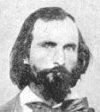 |
|
spring of 1874 played host to Dr. Charles Parry and has been described as a pioneer publicist, newspaper proprietor, herbalist and horticulturist, politician and businessman. He was born in Pomfret, New York. He moved to Kirtland, Ohio in 1832 and was baptized into the Church of the Latter Day Saints the following year. In 1840 he was teaching school in Springfield, Illinois, and then moved to Nauvoo, Illinois, which was a center of the Church, and got married there. He moved again to what is now Council Bluffs, Iowa, in 1848, where he was postmaster and a |
member of the first city council. His newspaper career began when he started the Council Bluffs Bugle in 1852, the Omaha (Nebraska) Arrow in 1854, the Crescent City Oracle in 1857, and the Council Bluffs Press in 1858. Never being a person who liked to stay in one place, he moved to Utah in 1861 and then to St. George a few years later, establishing a garden supply and nursery and starting a number of newspapers and periodicals. In 1882 he was settling in Tempe, Arizona, where he died. Along the way he had built stores, been with Joseph Smith the day before he was murdered, and wrote about routes for the Pacific Railroad. Dalea johnsonii was published by Sereno Watson in 1871 and Sclerocactus johnsonii was originally published by George Engemann. (Photo credit: Find-a-Grave)
-
johnson'ii: named for Leigh Alma Johnson (1966- ), an American botanist educated at Brigham Young University who worked in the area of natural history and natural resource management in various regions of the US and since 1999 is an associate professor and associate curator of the herbarium in the department of integrative biology at Brigham Young University. (Linanthus dichotomus ssp. johnsonii)
-
Johnstonel'la/johnston'ii: named for Ivan Murray Johnston (1898-1960), one of the leading American systematic botanists of the first half of the 20th century and an authority on the family Boraginaceae not only in America but worldwide with more than 50 articles published on that family. He was born in Los Angeles and became interested in the local flora and making field observations while in high school, collecting plant samples and sending specimens to local botanists for help with identification. He studied at Pomona College in Claremont, California, and at the University of California, Berkeley, where he received his degree in 1919. He also got his MA from Berkeley and then a doctorate at Harvard in 1925. His thesis was on the North American species of Cryptantha. During the summers of his college years he worked at the Alpine Laboratory of the Carnegie Institution. He was associated with some of the leading lights of botany in California, people like Alice Eastwood, Harvey Monroe Hall, Willis Lynn Jepson, Philip Munz, Townsend Stith Brandegee, Samuel Parish and William Albert Setchell. He did field work in the San Gabriel Mountains and the Claremont area. From October, 1925 to May, 1926 he worked and collected in Chile, exploring areas from the dry lowland deserts to 17,000’ Andean locales, many of which have never been revisited because they are so difficult to get to. In 1927, 1929 and from 1932 to 1933, he made a number of trips to study at European herbaria and made contact with European botanists. He maintained a strong interest in the desert flora of South America until the end of his life. In 1938, 1940 and 1941 he made three trips to the intermontane plateau and deserts of northern Mexico. The two most significant things that emerged from his trips was his understanding of the relationships of the desert floras of North and South America, and the relationship of vegetation types to soils. In 1955-1956 he made four trips to Central America collecting plants and gathering data. For the remainder of his life he was associated with the Arnold Herbarium at Harvard, becoming a lecturer in 1934 and associate professor in 1938. He eventually became supervisor of the herbarium and library and then was made associate director of the herbarium from 1948 to 1954. He was a member of the American Academy of Arts and Sciences, the American Society of Plant Taxonomists, the Botanical Society of America and the International Association of Plant Taxonomists. His plant collections are housed in the Rancho Santa Ana Botanic Garden, in Claremont, and in the Gray Herbarium of Harvard University. The genus Johnstonella which is a former genus name that has been resurrected was published by August Brand in 1925. (Species in Allium, Amsinckia, Arabis, Astragalus, Atriplex, Camissonia, Cryptantha, Eleocharis, Eriogonum, Galium, Gnaphalium, Lonicera, Lupinus, Mimulus, Polygonum, Rosa and Zauschneria)
-
john-tuck'eri: named for John Maurice Tucker
(1916-2008), a professor emeritus of botany, University of California,
Davis,
1955. Tucker grew up in California, and went to Santa Barbara
State College (now UCSB), 1934-38, receiving an AB with honors 1940
and a PhD in 1950 at Berkeley. He was originally interested in forestry,
then turned to oaks after a trip to El Salvador. As a graduate student at UC Berkeley he was hired as the director of the UC Davis botany department herbarium which has now become the J.M. Tucker Herbarium, a position he held for 39 years. During that time the collection grew from just 9,400 specimens to over 300,000. He also was director of the UC Davis Arboretum for 12 years. He devised the keys and wrote the species descriptions for the oak family treatment in the 1st edition of the Jepson Manual and completed a revision for the 2nd edition not long before his death. He was particularly interested in hybridizations between oak species.
-
jokerst'ii: named for Sacramento botanist James Dent Jokerst (1956-1995).
The following is quoted from a website of the American Society of
Plant Taxonomists: "Jim was born on 27 February 1956 in Denver,
Colorado, but he spent most of his life in California. He attended
California State University, Chico, where he received his BS (1978)
and MS (1981) degrees in botany. His graduate thesis was based on
a study of the pollination biology of Calochortus species.
He joined Jones & Stokes Associates [an environmental consulting
firm] in 1985, where he served as an associate principal and leader
of the botanical resources group. Jim Jokerst will be remembered as
one of the foremost authorities on the flora and ecology of California's
vernal pools, which are the focus of considerable controversy between
the state's conservation and development communities. He developed
objective methodology for selecting and ranking candidate vernal pool
preserves, based on the quality, species diversity, representativeness,
and preservation feasibility of a set of candidate preserve sites.
He was known for his encyclopedic knowledge of California flora, soils,
climate, hydrology, and geomorphology and his expert grasp of state
and federal environmental laws. His outgoing, honest personality and
keen sense of humor enabled Jim to develop close working relationships
with environmental professionals in both the public and private sectors.
These traits, coupled with his technical expertise, enabled him to
resolve the most complex and controversial environmental problems
with impeccable scientific data and objectivity. Jim described two
new plant species, Monardella beneolens (Lamiaceae) from the
southern crest of the Sierra Nevada, and Pogogyne floribunda (Lamiaceae) from the Great Basin in northeastern California. In addition
to his many technical reports, he contributed articles on California
floristics and conservation biology to a variety of journals, including Madroño, Fremontia, Phytologia, and Aliso.
He also prepared the descriptions and taxonomic keys for Acanthomintha, Monardella, and Pogogyne for the new Jepson Manual of
the flowering plants of California. His involvement in many professional
organizations included his service for the California Native Plant
Society on the Rare Plant Advisory Committee and the Natural
Community Scientific Advisory Committee, and he represented CNPS on
the US Forest Service Issues Statewide Conservation Committee. He
was a volunteer preserve manager at The Nature Conservancy's Vina
Plains Preserve near Chico, an important contributor to the California
Department of Fish and Game's Natural Diversity Data Base, a field
associate with the California Academy of Science, and a member of
the Natural Areas Association, the Ecological Society of America,
the California Botanical Society, and the American Society of Plant
Taxonomists. Jim received the Chevron National Environmental and Conservation
Award in 1988 for his many voluntary contributions to conservation,
and he received the CNPS Rare Plant Conservation Award in 1992 for
his outstanding contributions to rare plant conservation in California.
Throughout his life, Jim was drawn to the wilderness and he felt most
comfortable there. He was an accomplished backcountry skier, mountaineer,
and whitewater canoeist. Mountain peaks and desert lowlands were of
equal interest, as long as rare plants could be found and wild landscapes
were available to explore. His many colleagues remember Jim Jokerst
as a world-class botanist and ecologist, author, teacher, leader,
and cherished friend." He was also the author of The Vascular
Plant Flora of Table Mountain, Butte County, California. He died
in a tragic drowning incident at the age of 39.
-
jolonen'sis: named for the
town of Jolon (pronounced ho-lone), California,
located in Monterey County. The California flora iincludes both Brodiaea jolonensis and Clarkia jolonensis.
- jones'ii: named for Marcus Eugene Jones (1852-1934), a
self-taught geologist and botanist who worked as a private
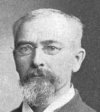 |
|
explorer and mining engineer for a railroad company in Salt Lake City, making numerous collecting trips to Mexico, Baja California, British Columbia and throughout the western states. He was born at Jefferson, Ohio, and moved with his family to a farm in Iowa, where he later received bachelor's and master's degrees at Iowa (Grinnell) College. He taught Latin and botany for four years and during the summers collected plant specimens from Iowa, Colorado and Utah, many of which were sent to Asa Gray or George Engelmann. He became embroiled in conflict with Charles |
Parry whom he accused of stealing and publishing a rose he had found. Parry had him banned from publishing in several top botanical journals. An apparent lover of controversy, he became caught up in a national debate between eastern and western botanists throughout the botanical field on whether western botanists should have to clear all names and descriptions of the western plants they were discovering with Asa Gray at Harvard, or whether they had the right to name and describe them themselves. In order to express his opinions on the matter, he became one of the first self-publishers and subsequently released eighteen issues of a journal he called Contributions to Western Botany, in which he supported the botanists of his own region, while at the same time making no secret of his sarcastic and somewhat negative opinions of some of his fellows. He referred to Edward L. Greene, for whom he had a particular dislike, as a botanical crook, moral reprobate, and an unmitigated liar, and he called Wilhelm Suksdorf a "hopeless splitter," referring to the manner in which the latter created new species without any justification for doing so. In 1894 alone he collected 50,000 specimens for the USDA. He collected on at least four of the Channel Islands, San Clemente, Santa Catalina, Santa Cruz and Santa Rosa. He described over 700 species of plants many of which were new to science. He also sailed his catamaran on Great Salt Lake and wrote articles about it, and was a preacher in the Congregational Church. After the death of his wife in 1916 he lived in Claremont, California. Toward the end of his life, he sold his extensive collection of 100,000 specimens for $25,000 to Pomona College where he spent a good deal of time, and that collection now resides at the California Botanical Garden. He was a life-long member of the Congregational Church and was a preacher himself. In 1934 he was killed in a traffic accident in his Model T while returning from a collecting trip in the San Bernardino Mountains. He has been described as "an irascible old codger" and despite never completing the flora he began for the Great Basin region, his contributions to the field of botany were many and significant.
-
jordal'ii: named for Louis Henrick Jordal (1919-1951), an American botanist and botanical collector in Alaska, killed in a plane crash.
-
jordan'ii: named for Rudolf Jordan, Sr. (1818-1910),
born in Halle, Germany of French Huguenot extraction. After a
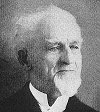 |
|
brief period
of military service, he embarked on what would be a lifetime of various
entrepreneurial and business activities. A desire for something exotic
and an interest in tropical climes took him to Cuba where he worked
as a clerk for Godefroy and Company for a couple of years and then became involved with daguerreotype
photography, then in its infancy. Hearing in 1848 about the possibility of
gold being found in California, he and a companion sailed for Vera Cruz. Narrowly avoiding death on several occasions, they traveled across Mexico and eventually took a ship to |
San Francisco, finally reaching Tuolumne County, where he engaged in placer mining that was
moderately profitable and held his interest for a while. It seems
he was always looking for something else because the list of things
he pursued was a long one and the numbers of partners he had and firms
he worked for was large. He was involved in selling and trading products,
trying to develop new items of equipment like a gold-washing machine
and a fan-wheel for fruit drying, various agricultural endeavors,
flour mills, log cutting and pearl fisheries. Later in his life, in 1863, he
returned to Germany with his wife and took with him many plant specimens
he had collected to be studied there by Professor Karl Mueller at
the University of Halle. One of these was a species of maidenhair
which the professor declared to be a new species and was named for
Jordan. Many commercial goods of his were destroyed in the 1851 fire
in San Francisco and then suffered through the great quake and fire
of 1906. He was an accomplished linguist, being comfortable in Spanish,
English, and French as well as German. In 1875 he brought his family back to America, where he invested in mining and real estate interests. For ten years he owned and operated Lotus Farm which was a vineyard and olive farm in the Napa redwoods area. He was happily married from 1856
until his wife died in 1901, and had children and grandchildren to whom he was equally devoted. (Photo credit: Napa Valley Register)
- josephinen'sis: refers ro Josephine County, Oregon. Streptanthus glandulosus ssp. josephinensis is a taxon in the Jepson eflora feom Del Norte County just across the border from Oregon, although the website Oregon Flora considers it endemic to Oregon.
-
juba'ta/juba'tum: crested or maned, with long awns, from Latin jubatus, "maned," from juba, "a mane, flowing hair on the neck of an animal."
-
juda'ica: of or from Judea or as it is sometimes spelled Judaea.
-
Jug'lans: a classical Latin name for walnut,
possibly from Ju or Jovis, "of Jupiter or Jove," and glans,
an acorn or nut, hence "Jove's nut" or "Jupiter's acorn." The common name "walnut" derives from the Old English wealhhnutu, literally meaning 'foreign nut,' from wealh, "foreign," and hnutu, "nut," because it was introduced from Gaul and Italy. The Latin name for the walnut was nux Gallica, "Gallic nut." The genus Juglans was published by Carl Linnaeus in 1753.
-
julibris'sin: the species name, julibrissin, comes from the Persian word "gul-i brisham" which means silk flower. Albizia julibrissin (the only taxon in Calornia with this epithet) is known as the silk tree.
-
junak'ii: named for Steven Alan Junak (1949- ), a botanist at the Santa Barbara
Botanic Garden, collector and
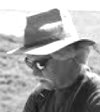 |
|
authority on the Channel Islands, author
with others of The Flora of Santa Cruz Island. He was born in Chicago and was educated at the University of Santa Barbara. He received his MA in botany and has also authored A Flora of San Nicolas Island. He is an expert on the flora of the Channel Islands and has led field trips there over the past twenty-five years. He has botanized in Mexico and Peru. Steve has retired from his long-held position as curator of the garden's herbarium. His main expertise is in botanical inventories; monitoring and mapping of rare plant |
species and invasive plant species, and the flora of the Channel Islands. He is a fellow of the Linnean Society of London and a member of the American Society of Plant Taxonomists, the California Botanical Society, the Torrey Botanical Club and Southern California Botanists.
-
jun'cea/jun'ceum: rush-like,
referring to the leafless stems, from Juncus, "a rush."
-
juncifo'lia: with leaves like Juncus.
-
Jun'cus: the classical Latin name for the rush,
possibly from jungere, "to join or bind," because
the stems were used for binding. The genus Juncus was published by Carl Linnaeus in 1753.
-
june'ae: named for June Jensen, grandmother of botanist Nick Jensen, author of Streptanthus juneae, who sparked his curiosity in the natural world. The taxon is called June's jewelflower.
-
Jungerman'nia: named for Ludwig Jungermann (1572-1653), a German botanist and physician born in Leipzig, a
 |
|
botanist who wrote most of the descriptive text of the Hortus Eystettensis, which was a codex produced by Basilius Besler in 1613 of the garden of the bishop of Eichstätt in Bavaria, Johann Konrad von Gemmingen, compiled over sixteen years. His father was a professor of law, but he chose to study medicine. Upon completion of his study, he went first to Nuremberg and then from 1614 to 1625 he was professor of anatomy and botany in Giessen. He declined a call to the prestigious department of botany in London as the successor of Matthias Lobelius in 1616, and |
likewise declined invitations to the Universities of Rostock and Rinteln. In Giessen he established a botanical garden which is the oldest such in Germany, still at its original location. In 1625 he accepted a professorship in anatomy and botany at the University of Altdorf. He was known for local floras such as his flora of Altdorf published in 1615, and a flora of Giessen entitled Cornucopiae Florae Giessensis (1623). The genus Jungermannia was published by Carl Linnaeus in 1753.
- juniper'ensis: the -ensis ending denotes a geographical location, as with nevadensis, idahoensis, utahensis and diegoensis, but it may also refer to a habit as with arvensis, "of the fields," and that is evidently what is the case here, so something like "of places with junipers."
-
juniperi'num: resembling Juniperus,
bluish-brown, like berries of juniper.
-
junipori'num: alternative spelling of the previous entry.
-
Junip'erus: a Latin name for juniper. The genus Juniperus was published by Carl Linnaeus in 1753.
-
juratzka'na/juratzka'num: named for Jakob Juratzka (1821-1878), a German/Austrian physician and bryologist, author of numerous papers on mosses. His herbarium collection is among the oldest collections in Serbia with great historical, botanical and conservation importance housed in the natural history collection of the National Museum of Kikinda. He was born in the Czech Republic and died in Vienna. He was also honored with the genus Juratzkaea in the Stereophyllaceae which was published in 1866 by Paul (Pablo) Günther Lorentz.
-
jussel'lii: named for Martin Simon Jussell (1877-1969), a teacher and enthusiastic collector of California plants. He was born near Eagle, Nebraska, and graduated from the University orf Nebraska in 1910. He moved to California two years later and settled in Oakland in 1922. He taught at various times at Lowell, Polytechnic and Mission High Schools in San Francisco, seventeen years at Polytechnic. He retired in 1946.
-
Jussiae'a: named for Antoine de Jussieu (1686-1758) (picture above) and Bernard de Jussieu (1699-1777) (picture
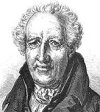 |
|
below). Antoine was a French botanist and physician born in Lyon. He studied medicine at the University of Montpellier and traveled with his brother Bernard through Spain, Portugal and southern France collecting plants. In 1708 he became the director of the Jardin du Roi, succeeding Joseph Pitton de Tournefort. By 1711 he was a member of the Academy of Sciences. He wrote many papers on human anatomy, zoology, paleontology, mineralogy and botany, and edited a new and revised edition of Tournefort's Institutions rei herbariae and a posthumous work of Jacques Barrelier entitled Plantae per Galliam, Hispaniam, et Italiam observatae. He practiced medicine, chiefly devoting himself to the very poor. The following entry about Bernard de Jussieu is quoted from the online Catholic Encyclopedia. "Bernard was born at Lyons, 17 August, 1699 and died at Paris, 6 November, 1777; the date of death is sometimes given as 1776. He was educated at the large Jesuit college at Lyons until he had finished the study of rhetoric. In 1716 he accompanied his brother Antoine on the latter's journeys to Spain, and developed into an enthusiastic botanist. He |
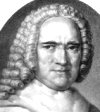 |
studied medicine at Montpellier, obtaining his degree in 1720, but practiced medicine only for a short time. He was called to Paris by his brother Antoine, at the request of the botanist Vaillant, and after Vaillant's death in 1722 was appointed the latter's successor as professor and assistant demonstrator at the Jardin du Roi. He devoted all his energies to the royal garden, which his brother Antoine left almost entirely to him. He also made botanical excursions in the country surrounding Paris, and was able in 1725 to issue a revised and enlarged edition of Tournefort's work, " Histoire des plantes des environs de Paris," this publication gained his admission into the Academy of Sciences. Many persons studied botany under his guidance, such as the chemist Lavoisier. Owing to de Jussieu's unusual modesty and unselfishness he published very little, notwithstanding the wide range of his learning. He wrote an important paper on zoophytes, sea-organisms whose classification as plants or animals was then a matter of dispute. To study them he went three times to the coast of Normandy, proved in the "Mémoires" of 1742 that they belonged to the animal kingdom (before Peyssonel), and sought to classify them at this early date into genera. He also separated the whale from the fish and placed it among the mammals. The few botanical papers which he published (1739-1742) treat of three water plants. In 1758 Louis XV made de Jussieu superintendent of the royal garden at Trianon near Paris, in which all plants cultivated in France were to be reared. His greatest achievement is the system according to which he arranged and catalogued the plants in the garden at Trianon; it is called "the older Jussieu natural system of plants of 1759," or the Trianon system. Jussieu himself never published anything about his system, nor did he offer any explanation of his arrangement, or give it a theoretical foundation. The genera are not arranged systematically in groups according to a single characteristic, but after consideration of all the characteristics, which, however, are not regarded as of equal value. De Jussieu proposed three main groups, to which he gave no name; these contained altogether fourteen classes, with sixty-five orders or families. Beginning with the cryptogams, the system proceeds from the monocotyledons to the dicotyledons, and closes with the coniferæ. Before this Linnæus had pointed out that only the natural system should be the aim of botanical classification, and published, outside of his artificial system, fragments of a natural system as early as 1738. Compared to the present development of the natural system, both Linnæus and de Jussieu offer scarcely more than a weak attempt at a natural classification of plants, but their attempt is the first upon which the further development rests. De Jussieu was a thoughtful observer of nature, who behind things saw the laws and the mind which gave the laws. Notwithstanding the great range of his knowledge he was exceedingly modest and unselfish. He was always animated by an intense love of truth, and his influence in the Academy and over French scholars was very great. He was besides deeply religious, preserving his religious principles and acting upon them to the end of his life. An old biography says of him: ‘No one has proved better than he how religious feeling can be combined with many sciences and true knowledge.’ He was a member of numerous academies and learned societies, e.g. the academies of Berlin, St. Petersburg, Upsala, London, and Bologna. In 1737 Linnæus named for him the genus Jussieua, which belongs to the family of the Onagraceæ, and at the present day includes some thirty-six tropical species, chiefly South American." Their younger brother Joseph de Jussieu (1704-1779) was also a botanist, physician and explorer who introduced the common garden heliotrope ( Heliotropium arborescens) to European gardeners. In 1735 he went on a scientific expedition to Peru with stopovers in Martinique, Haiti and Panama. The work of the expedition was not completed until 1743 but Joseph remained in that area for 27 more years until he returned to Paris in 1771. His work had been significant but he published nothing, most of his collections lost in transit, and his manuscripts destroyed in Lima, and his health was broken. In a state of depression he lived for another eight years in the family residence cared for by Bernard and his nephew Antoine Laurent never leaving the house. He had been elected to the Academy of Sciences in 1742 but never attended a single session. The genus Jussiaea was published by Carl Linnaeus in 1753, probably for the same thing he had previously called Jussieua.
- Justic'ia: named for James Justice (1698-1763), a Scottish botanist, author and horticulturist, son of Sir James Justice.
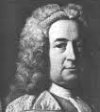 |
|
He was apparently the first person to successfully bring a pineapple to the fruiting stage in Scotland, became involved in the tulip bulb craze and died bankrupt. His passion for gardening experiments was almost an obsession, and his willingness to spend whatever he had on greenhouses, soil mixtures and tropical plants to the detriment of his family resulted in his divorce. His continual purchases of rare bulbs and plants eventually caused him to have to sell off his estate at Crichton. He was one of the first people in Scotland to write with first-hand horticultural |
knowledge about practical gardening in northern climates. Although his professional position was as principle clerk to the Court of Session in Edinburgh, in his leisure time he studied the problems of silviculture which he experimented on at his estates. Sometimes irascible and overly opinionated, he was an enthusiastic gardener. His works on gardening, such as The Scots Gardiner and The British Gardener, were distributed in much of Britain, Scotland and Ireland. He was a fellow in the Royal Society but was expelled from that group for non-payment of his annual subscription. His collection of succulents was said to be the first in Scotland. He was eccentric, controversial but without question a pioneer. The genus Justicia was published in his honor by Carl Linnaeus in 1753.
|
